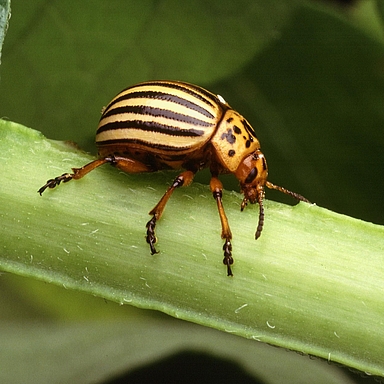Project A.14

- PhD student: Himrekha Agarwal
- Supervisor: Shuqing Xu
- Co-Supervisors: Marion Silies
- Further TAC-members: Stefanie Ryglewski
- Research Group
The Colorado Potato Beetle (CPB), Leptinotarsa decemlineata produces a neurotoxin, leptinotarsin in its hemolymph, which is lethal to other insects and vertebrates. My project aims to investigate the evolutionary and molecular mechanisms underlying leptinotarsin production and self-tolerance in CPB using a combination of functional neurobiology and evolutionary genetics approaches.
Many insects produce toxins as an essential constituent of the hemolymph and not in a separate gland. It hints towards a fine difference in their biochemistry allowing them to function normally in the presence of a substance, which is otherwise toxic to other organisms. How do these organisms regulate the production of such toxins and evolve self-resistance at the cellular level? The hemolymph CPB also produces a high abundance of leptinotarsin, a presynaptic neurotoxin that is lethal to many insects and vertebrates when injected (1). CPB is a major pest of potato crops throughout North America, known for its impressive insecticide resistance.
On injection, leptinotarsin promotes a sustained influx of calcium ions, thereby causing the release of neurotransmitters from the presynaptic terminals (2). We suspect voltage-gated calcium channels (VGCC) to be a target for the toxin and hence, we will be employing electrophysiological techniques to validate it and identify the specific type of VGCC involved. Moreover, using Drosophila melanogaster as a heterologous expression system to express the VGCC of the beetle, we plan to gain insights into the self-resistance mechanism. Our preliminary data also suggests that the genes expressing the presynaptic calcium channels underwent a gene duplication event, eventually leading to some insect species maintaining the duplicated copy and others losing it. It would therefore be very interesting to explore if such evolutionary processes played a role in organisms being able to tolerate their toxin.
Contrary to the lethal effect seen on injection of the CPB hemolymph into the organisms, there is no evidence of oral toxicity suggesting no natural role as a toxin (1). Most of the other organisms which are known to produce such toxins use it either for defense or predation. It makes us wonder why CPB harbors a potential toxin in its body, if not for defense and protects itself at the same time. The presence of the toxin in all life stages of CPB indicates an important metabolic role or possibly, some pleiotropic functions. Using a gene knock-out-based approach and toxicity assays, we plan to investigate its function and unravel the cellular regulatory and detoxification mechanisms on a transcriptomic and proteomic level. Several species of the Leptinotarsa genus produce the toxin but show species-specific mechanisms of action and potency (3,4). To understand it further, we will use comparative genomics to analyse the evolutionary relationships of toxin production and tolerance across Leptinotarsa species. My project will therefore allow us to gain a better picture of how cellular defenses in organisms are regulated at genetic and evolutionary levels.
References:
1. T. H. Hsiao, G. Fraenkel, Properties of leptinotarsin. (1969). A toxic hemolymph protein from the Colorado potato beetle. Toxicon 7, 119-130.
2. Crosland, R. D., Fitch, R. W., & Hines, H. B. (2005). Characterization of β-leptinotarsin-h and the effects of calcium flux antagonists on its activity. Toxicon, 45(7), 829-841.
3. Hsiao, T. H. (1978). Comparative studies on hemolymph protein toxins of Leptinotarsa beetles. Toxins, 675-688.
4. Yoshino, J. E., Baxter, D. E., Hsiao, T. H., & McClure, W. O. (1980). Release of acetylcholine from rat brain synaptosomes stimulated with leptinotarsin, a new neurotoxin. Journal of Neurochemistry, 34(3), 635-642.